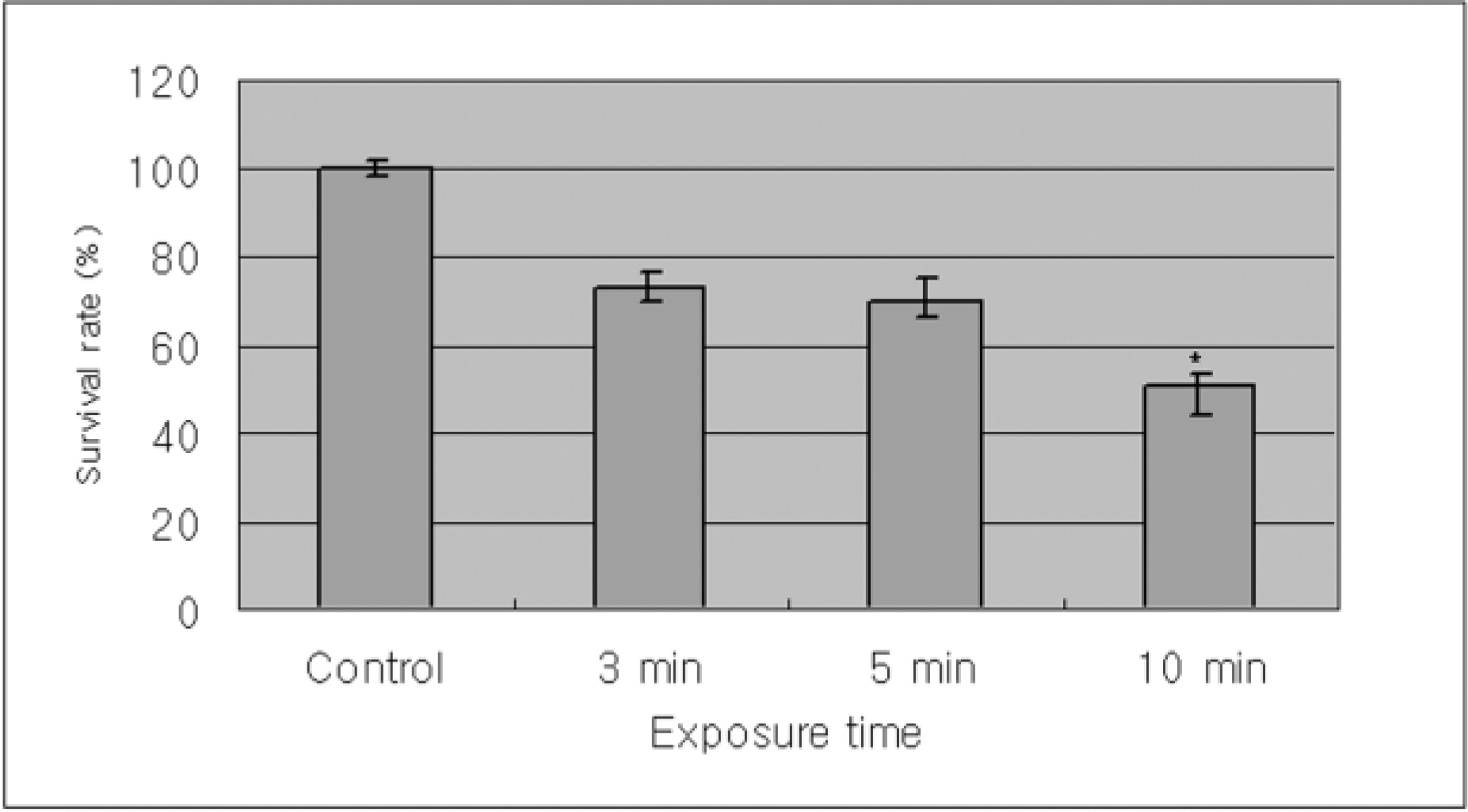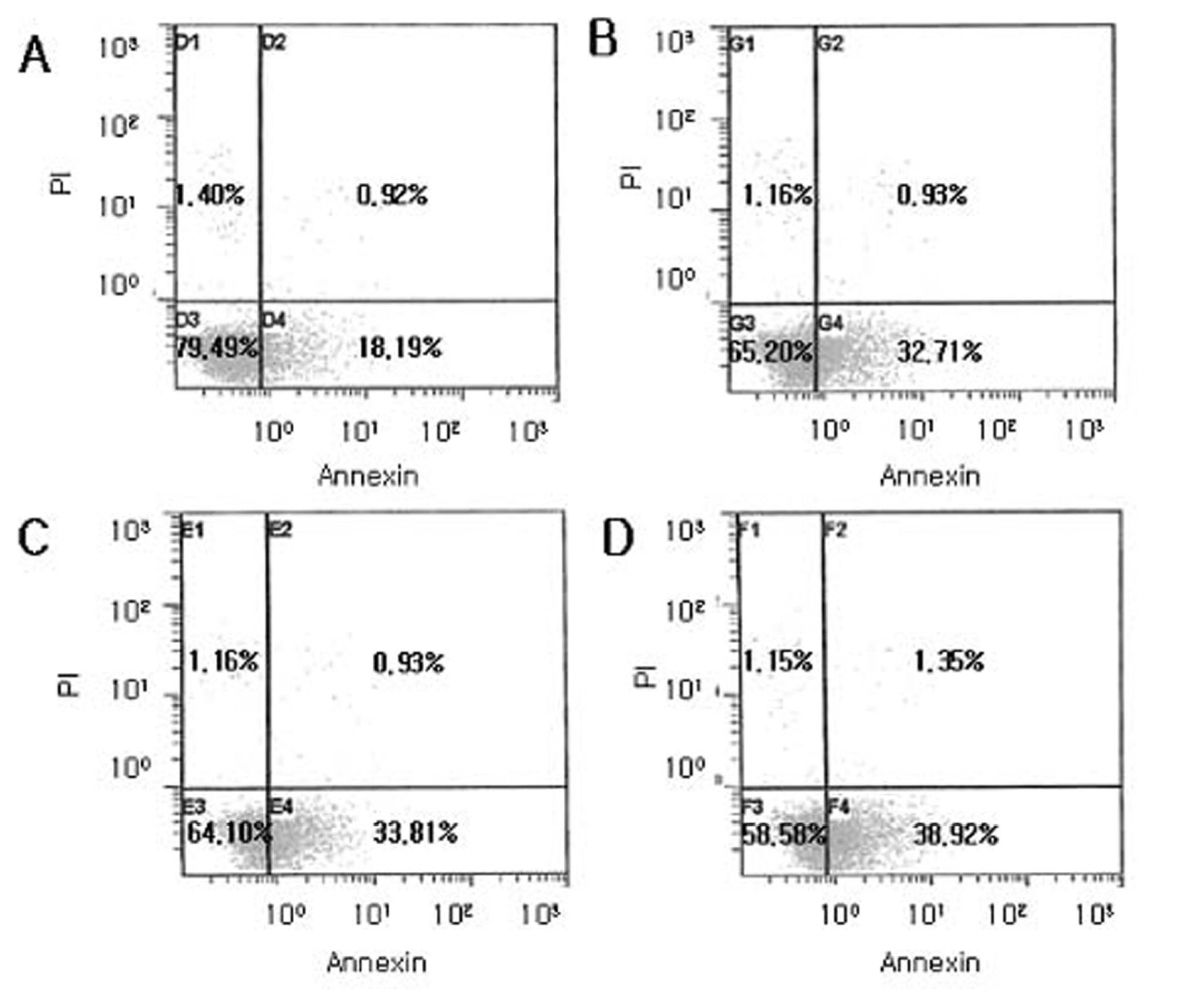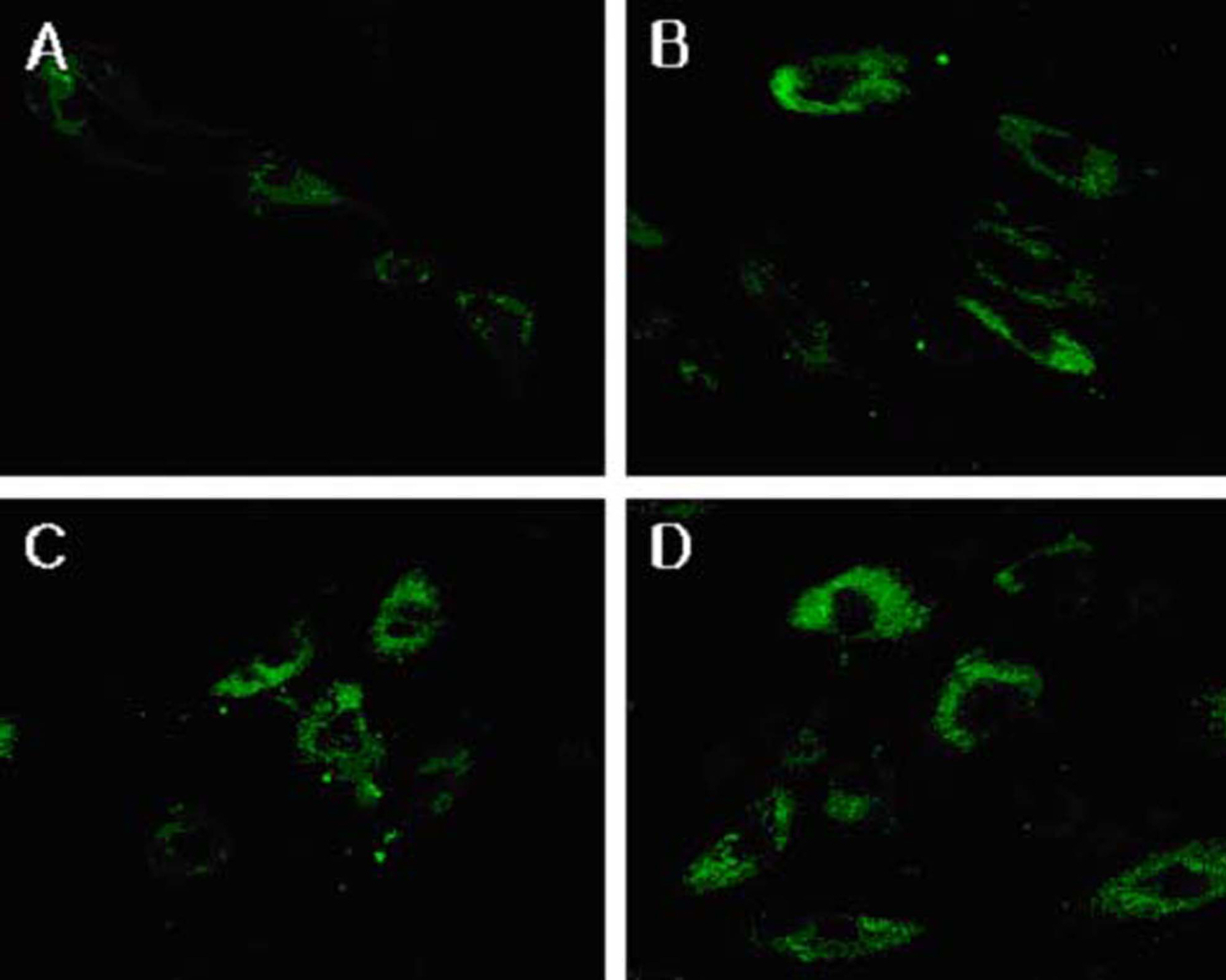J Korean Ophthalmol Soc.
2007 Oct;48(10):1399-1409. 10.3341/jkos.2007.48.10.1399.
Effect of Cyclosporine A 0.05% on Human Corneal Epithelial Cells
- Affiliations
-
- 1Department of Ophthalmology, Pusan National University College of Medicine, Pusan National University, Pusan, Korea. jongsool@pusan.ac.kr
- 2Shin's Eye Clinic, Pusan, Korea.
- KMID: 2210995
- DOI: http://doi.org/10.3341/jkos.2007.48.10.1399
Abstract
-
PURPOSE: To evaluate the toxic effect of topical cyclosporine on cultured human corneal epithelium and to investigate the apoptotic response and cellular morphologic changes associated with cyclosporine in vitro.
METHODS
Human corneal epithelial cells were exposed to a concentration of cyclosporine A (0.05%) for a period of 3, 5, and 10 minutes. MTT-based calorimetric assay was performed to assess the metabolic activity of cellular proliferation and lactate dehydrogenase (LDH) leakage assay for cytotoxicity. Apoptotic response was evaluated with flow cytometric analysis and fluorescence staining with Annexin V and propiodium iodide. Cellular morphology was evaluated by inverted phase-contrast light microscopy and electron microscopy.
RESULTS
The inhibitory effect of human corneal epithelial cell proliferation and cytotoxicity showed a time-dependent response and had a significant effect when exposed for 10 minutes (P=0.04). The maximun response did not reach the leathal dose (LD)50. Apoptosis was seen in flow cytometry and apoptotic cells were demonstrated in fluorescent micrograph after being treated treating with cyclosporine A (0.05%). Human corneal epithelial cells were more detached from the bottom of the dish and damaged cells show degenerative changes like microvilli disappearance, vacuoles formation, and chromatin of the nuclear remnant condensed along the nuclear periphery.
CONCLUSIONS
Cyclosporine A (0.05%) could be used without any significant toxic effect on human corneal epithelial cells except for exposure times longer than 10 minutes. Induction of apoptosis modulation may be one of the cyclosporine's mechanism for inhibiting cellular proliferation.
Keyword
MeSH Terms
Figure
Cited by 2 articles
-
Effect of Mitomycin C, Dexamethasone, and Cyclosporine A 0.05% on the Proliferation of Human Corneal Keratocytes
Jong Hoon Shin, Soo Jin Kim, Ji Eun Lee, Jong Soo Lee
J Korean Ophthalmol Soc. 2011;52(10):1215-1221. doi: 10.3341/jkos.2011.52.10.1215.Effects of Low-Dose Cyclosporine on Human Corneal Epithelial Cells
Sang Jun Lee, Su Jin Kim, Jong Soo Lee
J Korean Ophthalmol Soc. 2011;52(11):1344-1350. doi: 10.3341/jkos.2011.52.11.1344.
Reference
-
References
1. Hill JC. High risk corneal grafting. Br J Ophthalmol. 2002; 86:945.
Article2. Poon AC, Forbes JE, Dart JKG, et al. Systemic cyclosporin A in high risk penetrating keratoplasties: a case-contral study. Br J Ophthalmol. 2001; 85:1464–9.3. Hill JC. Immunosuppression in corneal transplantation. Eye. 1995; 9:247–53.
Article4. Hill JC. Systemic cyclosporine in high-risk keratoplasty: short versus long term therapy. Ophthalmology. 1994; 101:128–33.5. Minguez E, Tiestos MT, Cristobal JA, et al. Intraocular absorption of cyclosporin A eyedrops. J Fr Ophthalmol. 1992; 15:263–7.6. BenEzra D, Maftzir G. Ocular penetration of cyclosporin A: the rabbit eye. Invest Ophthalmol Vis Sci. 1990; 31:1362–6.7. Lightman S. New therapeutic options in uveitis. Eye. 1997; 11:222–6.
Article8. Chen J, Xie H, Wang Z, et al. Mooren’ ulcer in China: a study of clinical characteristics and treatment. Br J Ophthalmol. 2000; 84:1244–9.9. Kunert KS, Tisdale AS, Stern ME, et al. Analysis of topical cyclosporine treatment of patients with dry eye treatment: effect on conjunctivla lymphocytes. Arch Ophthalmol. 2000; 118:1489–96.10. Stevenson D, Tauber J, Reis BL. Efficacy and safety of cyclosporin A ophthalmic emulsion in the treatment of moderate-to-severe dry eye disease: a dose-ranging, randomized trial. The Cyclosporin A Phase 2 Study Group. Ophthalmology. 2000; 107:967–74.11. Sall K, Stevenson OD, Mundorf TK, Reis BL. Two multicenter, randomized studies of the efficacy and safety of cyclosporine ophthalmic emulsion in moderated to severe dry eye disease. CsA Phase 3 Study Group. Ophthalmology. 2000; 107:631–9.12. Hingorani M, Calder VL, Buckley RJ, Lightman S. The immunomodulatory effect of topical cyclosporin A in atopic keratoconjunctivitis. Invest Ophthalmol Vis Sci. 1999; 40:392–9.13. Stern ME, Geo J, Siemasko KT, et al. Role of the lacrimal gland functional unit in the pathophysiology of dry eye. Exp Eye Res. 2004; 78:409–16.14. Pepose JS, Akata RF, Pflugfelder SC, et al. Mononuclear cell phenotypes and immunoglobulin gene rearrangements in larimal gland biopsies from patients with Sjogren's syndrome. Ophthalmology. 1990; 97:1599–605.15. Borel JF, Baumann G, Chapman I, et al. In vivo pharmacological effects of ciclosporin and some analogues. Adv Pharmacol. 1996; 35:115–246.
Article16. Laibovitz RA, Solch S, Andriano K, et al. Pilot trial of cyclosrpoine 1% ophthalmic ointment in the treatment of keratoconjunctivitis sicca. Cornea. 1993; 12:315–23.17. Power WJ, Mullaney P, Farrel M, et al. Effect of topical cyclosporin A on conjunctival T cells in patients with secondary Sjogren's syndrome. Cornea. 1993; 12:507–11.18. Singh G, Lindstrom RL, Doughman DJ. Cyclosporin A on human corneal endothelium. Cornea. 1984; 3:272–7.
Article19. BenEzra D, Antebe I, Maftzir G. Differential effect of cyclosporin A on lymphocyte and keratocyte proliferation. Invest Ophthalmol Vis Sci. 1987; 28:42.20. Garweg JG, Wegmann-Burns M, Goldblum D. Effects of daunorubicin, mitomycin C, azathiprine and cyclosporin A on human retinal pigmented epithelial, corneal endothelial and conjunctival cell lines. Graefes Arch Clin Exp Ophthalmol. 2006; 244:382–9.21. Angelov O, Wiese A, Yuan Y, et al. Preclinical safety studies of cyclosporine ophthalmic emulsion. Adv Exp Med Biol. 1998; 438:991–5.
Article22. Tonoe O, Yamanaka O, Okada Y, et al. Collagen biosynthesis and cellular proliferation after filtering surgery in rabbits. Folia Ophthalmol Jpn. 1995; 46:242–5.23. Berman B, Duncan MR. Pentoxifylline inhibits normal human dermal fibroblast in vitro proliferation, collagen, glycoaminoglycan, and fibronectin production, and increases collagenase activity. J Invest Dermatol. 1989; 92:605–10.24. Leonardi A, DeFranchis G, Fregona IA, et al. Effects of cyclosporine A on human conjunctival fibroblasts. Arch Ophthalmol. 2001; 119:1512–7.25. Williamson MS, Miller EK, Plemons J, et al. Cyclosporine A upregulates interleukin-6 gene expression in human gingiva. J Periodontol. 1994; 65:895–903.26. James JA, Irwin CR, Linden GJ. Gingival fibroblast response to cyclosporin A and transforming growth factor beta 1. J Periodontol Res. 1998; 33:40–8.27. Adler R. Mechanism of photoreceptor death in retinal degeneration. From the cell biology of the 1990s to the ophthalmology of the 21st century. Arch Ophthalmol. 1996; 114:79–83.28. Thompson CB. Apoptosis in the pathogenesis and treatment of disease. Science. 1995; 267:1456–62.
Article29. Horigome A, Hirano T, Oka T, et al. Glucocorticoids and cyclosporine induce apoptosis in mitogen-acitvated human peripheral mononuclear cells. Immunopharmacology. 1997; 37:87–94.30. Walter DH, Haendler J, Galle J, et al. Cylcosporin A inhibits apoptosis of human endothelial cells by preventing release of cytochrome C from mitochondria. Circulation. 1998; 98:1153–7.31. Healy E, Dempsey M, Lally C, Ryan MP. Apoptosis and necrosis. Kidney Int. 1998; 54:1955–66.
- Full Text Links
- Actions
-
Cited
- CITED
-
- Close
- Share
- Similar articles
-
- Effects of Low-Dose Cyclosporine on Human Corneal Epithelial Cells
- Effect of Mitomycin C, Dexamethasone, and Cyclosporine A 0.05% on the Proliferation of Human Corneal Keratocytes
- Long-term Outcome of Limbal Epithelial Cells Cultivated in Vivo on Amniotic Membrane Transplantation
- Transplantation of in vivo Cultivated Limbal Corneal Epithelial Cells with Total Limbal Stem Cell Deficiency
- The Study of the Effects of Glucose on Cultured Human Corneal Epithelial Cells








